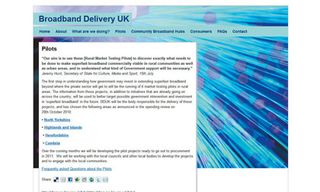Is there no broadband at all in your region? If you can't wait for the super-fast broadband rollout to make it to your area, or think that your MP isn't shouting loud enough to ensure your region is earmarked for development, there here is one more option that's worth considering - you could start up your own ISP.
There's nothing stopping you going into business for yourself as your own internet service provider - all you need to do is research whether it's a viable solution for your area, find some investors and apply for the funding.
Sound hard? There are people you can ask for advice and communities that have already gone through the same process, albeit before this government funding was available. One community that wasn't willing to wait for broadband to come to its village was Lyddington in Rutland. Rather than waiting for a big company to come to the rescue, its residents banded together and raised the capital to lease BT's services and lay their own fibre-optic cables, turning their internet no-go zone into a digitally connected hub that offers the 200 homes in the village download speeds of up to 40Mbps.
To do this, Lyddington's residents joined forces with a local ICT company, which was able to resell BT's broadband service. Director Mark Melluish said, "For the first time in UK telecommunications history, the telephone lines of customers are completely cut off from the local BT exchange."
Now they use their experience of setting up the company to offer consultancy services for others considering doing it themselves.
How does BT feel about the practice? The company told us that it's happy to help companies set up their own broadband services. "This is a positive development as, to date, BT has been alone in investing in rural areas. In the case of Rutland Telecom, it is buying our Ethernet products such as Backhaul Extension Service (BES) and Sub Loop Unbundling (SLU)."
Be prepared
This isn't a task to be undertaken lightly though - it needs to be a proper business proposition and will require a lot of preparation, both legal and structural, followed by preparing for the costs and provisions of billing, customer service and maintenance.
Get daily insight, inspiration and deals in your inbox
Sign up for breaking news, reviews, opinion, top tech deals, and more.
However, it does put you in control of exactly what internet provisions your area will be getting, and if you do it fast enough, you could even take advantage of some of the money put aside for exactly this kind of development of broadband services in rural areas.
Develop a plan
As the Department for Culture, Media and Sport's website (www.culture.gov) states, "County councils, unitary authorities and Local Enterprise Partnerships can apply for a share of the money by developing a local broadband plan setting out how everyone in the area will be provided with superfast broadband access. Once the local plan is sufficiently developed, BDUK (Broadband Delivery UK) will allocate the funding and the work will be put out to tender to bidding suppliers".
If your business plan stands up to scrutiny - and there are consultancy services like Rutland Telecom that can help you to ensure you do all you can to make sure it does - then there's no reason why you wouldn't be in the running for funding.
Remember, the government is looking for effective solutions to the lack of broadband in rural areas, so you'll be doing it a favour by taking matters into your own hands. What's more, in order to make setting up an ISP a more attractive proposition to smaller companies and investors, telecoms regulator Ofcom has forced BT to drop its wholesale price by 12 per cent each year until 31 March 2014.
This means that anybody can take advantage of these competitive rates. The idea is to encourage stronger competition between ISPs in areas that have been traditionally ignored by larger organisations because of the costs involved in providing the service.
Money matters
So what are the actual costs involved in becoming your own ISP? Obviously the exact figures will vary depending on the length of fibre optic cabling that needs to be laid down and the number of telephone exchanges involved, but we can take Rutland Telecom's initial setup as an example.
In Lyddington, the costs for laying the cable to the village's exchange cabinet and replacing its innards with the latest fibre-to-the- home Ethernet technologies were covered by a £37,000 collaborative private investment - that's about £3,000 for each of the private investors.
As for money coming back in, each of the 200 Lyddington customers is paying £30 a month for the service. This does mean it will take a little while for the investors to recoup on their investment, but the service is doing well and at least they can access the internet while they wait.
How to set up your own ISP
1. Check it's the right approach

The first step is to check whether setting up an ISP is a sensible idea in your region. You can explore your options with organisations like the CBN, BDUK or companies like Rutland Telecom, which can help with the feasibility studies. Then you can work on a business plan so that you can demonstrate how your company is going to deliver its service to its customers and profits to its investors.
2. Organise the funding
It can cost tens of thousands of pounds to set up an ISP and lay the cable. There may be grants available for your region, but private investment seems to be the normal method of funding. This means finding 10 to 20 like-minded friends to invest a couple of grand each. If your business plan is sound, you should be able to off er them a reasonable return over the longer term, if the project is successful.
3. Get the lawyers in
There's a lot of red tape involved in setting up a company. Apart from the usual form-filling at Companies House, you'll need to sort out the planning permission for your infrastructure, the returns for the investors, the contracts with BT Openreach for using or taking over their phone lines and services, and the legal paperwork for the agreements on subscriptions and billing for your customers.
4. Buy/rent the technology
Investing in industrial technology is a costly business, especially if you're planning to future-proof your service. You'll need the latest fibre-to-the-home Ethernet switching technologies to replace your (likely) antiquated BT street cabinet, as well as the networking technologies required to make it all work. Covering the costs for buying or renting these needs to be covered by your business plan.
5. Trench warfare
Next, you need to lay your brand new fibre-optic cable and replace the innards of your village's BT street cabinet. Getting permission to dig up public highways isn't easy, so you'll need to plan for this part of the process a long way in advance. Then it's just a case of getting the workmen in - the whole job only took six hours to complete when Rutland Telecom performed the task in Lyddington.
6. Customer service
Now all you need to do is start billing your customers and provide some customer support should anything go wrong (like someone accidentally driving into your cabinet). Also, don't forget that now the Digital Economy Act is law, you'll be responsible for what your customers download using your servers, so policing their behaviour may be another cost that you need to consider.












